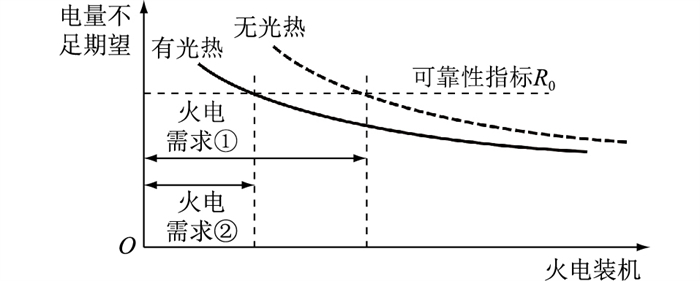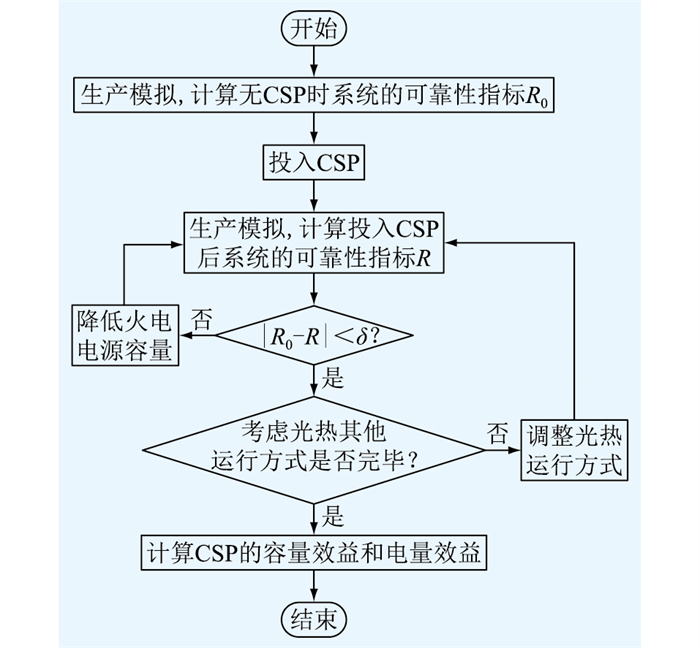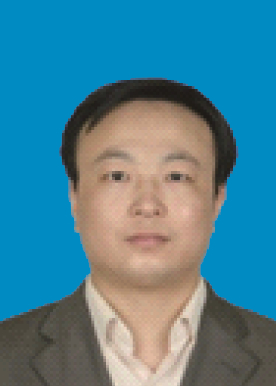文章编号: 2096-3203(2022)01-0213-06 中图分类号: TM615
2. 西安交通大学电气工程学院, 陕西 西安 710049
光热发电(concentrating solar power, CSP)具有清洁、调节性能好等优点,但同样受资源约束,其储热环节受储热容量限制,因此CSP的效益评估相比常规电源要复杂得多[1-3]。对于含有风电、光伏、光热、水电、火电、抽水蓄能、储能等多类型电源的系统,须综合考虑CSP的资源特性、运行方式、储热时长等,合理评估CSP在电网中的综合效益[4-7]。
文献[8]以减小系统运行成本、调峰成本和弃电成本为目标,协调考虑了CSP与直流输电线路的灵活调节能力。文献[9-10]建立光伏-光热联合模型,对含有光伏和CSP的系统优化运行进行了研究。文献[11-12]提出光热机组可以配合风电运行,降低风电机组的不确定性,进而降低系统的辅助服务需求并提高系统可靠性。文献[13]考虑光伏发电与负荷的相关性,分别计算白天及夜间光伏发电置信容量。在电力系统规划设计阶段,CSP参加装机平衡的规模大小对系统规划设计与调度运行至关重要[14-16],与资源特性、储热时长、调峰方式等密切相关[17-19]。文献[20]将多台CSP机组聚合成一台等效机组,从而减小问题规模、加快模型求解速度。文献[21]综合考虑火电调峰成本与储热成本,提出一种CSP储热容量配置方法。文献[22]对CSP的容量效益及其影响因素进行了研究。
CSP除了容量效益,还具有减少火电煤耗的电量效益,为全面评估CSP的效益,文中以系统供电可靠性不变为约束,对CSP的容量效益、电量效益进行了综合研究,采用8 760 h全时段生产仿真模拟法,模拟了火电启停、储能电源和光热跨日调节等因素。对西北地区实际电网进行仿真,分析了CSP的效益及影响因素,研究成果可为CSP的运行和合理发展规模确立提供参考。
1 CSP综合效益评估 1.1 CSP效益计算 1.1.1 容量效益CSP的容量效益是指系统因CSP而减少的常规电源装机需求。文献[22]以系统供电可靠性指标不变为约束,利用加入CSP后火电装机的减少量来衡量CSP的容量效益。文中采用该方法测算CSP的容量效益,图 1为CSP容量效益示意。

|
图 1 CSP容量效益示意 Fig. 1 Schematic diagram of capacity efficiency of CSP |
由图 1可知,若没有CSP,则可靠性指标为R0时,系统火电需求为①;加入CSP后,可靠性指标相同时,系统火电需求为②。加入CSP前后火电需求的差值即为CSP的容量效益,计算流程如下:
(1) 给定系统电源结构和规模,进行8 760 h生产模拟。计算无CSP时系统的电力盈缺情况,统计得到电量不足的数值R0,即可靠性指标;若系统的电力装机有盈余,则计算系统的火电装机需求。
(2) 加入CSP,逐步降低火电装机容量,进行生产模拟计算,直到其供电可靠性指标R与无CSP情况下供电可靠性指标R0相同。
(3) 比较CSP加入前后火电装机需求和系统煤耗,确定CSP的容量效益。
1.1.2 电量效益CSP的电量效益是指CSP投入运行后,火电发电量降低,从而减少的火电发电耗煤量。产生电量效益的原因主要有:(1) CSP加入系统后可以减少火电发电量;(2) 光热具有调节性能,可以降低风电和光伏的弃电率,从而增加风电和光伏发电量,降低火电发电量;(3) CSP可以改善火电运行条件,从而降低火电的煤耗。
1.1.3 综合效益对含有CSP的系统进行8 760 h生产仿真模拟,在系统供电可靠性指标保持不变的情况下计算CSP投运前后火电装机需求变化量和煤耗变化量,计算流程如图 2所示。

|
图 2 CSP容量效益和电量效益计算流程 Fig. 2 Flow chart of calculating capacity and electricity energy benefit of CSP |
CSP国民经济效益计算如下:
(1) 采用8 760 h生产仿真模拟,计算无CSP情况下,火电装机需求H1,系统煤耗M1。
(2) 加入CSP,给定运行方式,进行8 760 h生产仿真模拟,计算火电装机需求H2,系统煤耗M2。
(3) 计算CSP容量效益,即加入CSP后减少的火电装机需求。
| $ C_{{\rm{CSP}}}^{\rm{H}} = {H_1} - {H_2} $ | (1) |
(4) 计算CSP的电量效益,即加入CSP后减少的系统煤耗。
| $ {M_{{\rm{CSP}}}} = {M_1} - {M_2} $ | (2) |
(5) 计算CSP的综合效益。
| $ {R_{{\rm{CSP}}}} = {r_{\rm{H}}}{p_{\rm{H}}}C_{{\rm{CSP}}}^{\rm{H}} + {\alpha _H}{p_{\rm{H}}}C_{{\rm{CSP}}}^{\rm{H}} + {p_{\rm{M}}}{M_{{\rm{CSP}}}} $ | (3) |
式中:rH为火电生命周期内的资金回收系数;pH为火电单位装机容量造价;αH为火电运行维护费率;pM为标准煤的价格。
(6) 计算CSP的成本支出。
| $ {T_{{\rm{CSP}}}} = {r_{{\rm{CSP}}}}{p_{{\rm{CSP}}}}{C_{{\rm{CSP}}}} + {\alpha _{{\rm{CSP}}}}{p_{{\rm{CSP}}}}{C_{{\rm{CSP}}}} $ | (4) |
式中:CCSP为CSP的装机容量;rCSP为CSP生命周期内的资金回收系数;pCSP为CSP单位装机容量造价;αCSP为CSP运行维护费率。
(7) 计算CSP的国民经济净收益。
| $ {Q_{{\rm{CSP}}}} = {R_{{\rm{CSP}}}} - {T_{{\rm{CSP}}}} $ | (5) |
若CSP的国民经济净效益大于0,则建设光热电站是经济的,否则建设电站是不经济的。
1.2 生产模拟模型综合考虑新能源弃电量和发电煤耗,在满足负荷需求的情况下,尽量减少新能源弃电量和系统发电煤耗,目标函数为:
| $ \min \left\{ {\left. {{f_1} + {\lambda _1}{f_2} + {\lambda _3}{f_3} + {\lambda _4}{f_4} + {\lambda _5}{f_5} + {\lambda _6}{f_6}} \right\}} \right. $ | (6) |
| $ \left\{ {\begin{array}{*{20}{l}} {\begin{array}{*{20}{l}} {\begin{array}{*{20}{l}} {\begin{array}{*{20}{l}} {\begin{array}{*{20}{l}} \begin{array}{l} {f_1} = \sum\limits_{t = 1}^L {\sum\limits_{i = 1}^G {\left( {{C_{i, t}}\left( {{P_{i, t}}, {U_{i, t}}} \right)} \right.} } \\ \;\;\;\;\;\;\left. {Q_{i, t}^{{\rm{up}}}\left( {{U_{i, t - 1}}, {U_{i, t}}} \right) + Q_{i, t}^{{\rm{off}}}\left( {{U_{i, t - 1}}, {U_{i, t}}} \right)} \right) \end{array}\\ {{f_2} = \sum\limits_{t = 1}^L {\sum\limits_{b = 1}^B {\left( {{W_{b, t, 0}} - {W_{b, t}}} \right) + {\lambda _2}\sum\limits_{t = 1}^T {\sum\limits_{b = 1}^B {\left( {{S_{b, t, 0}} - {S_{b, t}}} \right)} } } } } \end{array}}\\ {{f_3} = \sum\limits_{t = 1}^L {\sum\limits_{i = 1}^H {{E_{i, t}}} } } \end{array}}\\ \begin{array}{l} {f_4} = \sum\limits_{t = 1}^L {\sum\limits_{i = 1}^N {\left( {{H_{i, t}}\left( {P_{i, t}^{\rm{s}}, P_{i, t}^{\rm{s}}} \right) + } \right.} } \\ \;\;\;\;\;\;\left. {M_{i, t}^{{\rm{up}}}\left( {U_{i, t - 1}^{\rm{s}}, U_{i, t}^{\rm{s}}} \right) + M_{it}^{{\rm{off}}}\left( {U_{i, t - 1}^{\rm{s}}, U_{i, t}^{\rm{s}}} \right)} \right) \end{array} \end{array}}\\ {{f_5} = \sum\limits_{t = 1}^L {\sum\limits_{b = 1}^B {{l_{b, t}}} } } \end{array}}\\ {{f_6} = \sum\limits_{t = 1}^L {\sum\limits_{b = 1}^B {{h_{b, t}}} } } \end{array}} \right. $ | (7) |
式中:f1为火电机组发电成本;f2为新能源发电的弃电量;f3为水电弃电量;f4为光热机组发电成本;f5为损失负荷成本;f6为损失备用成本;Ci, t为煤电机组i在时刻t的发电成本函数;Pi, t为机组i在时刻t的有功出力;Qi, tup,Qi, toff分别为机组i在时刻t的启动和停机费用;Ui, t,Ui, t-1为0-1变量,分别表示机组i在时刻t和时刻t-1的运行状态,为0表示关停,为1表示启动;λ1,λ2,λ3,λ4分别为弃风、弃光、弃水以及因光热机组调峰运行而造成效率降低的惩罚因子;λ5为失负荷惩罚因子;λ6为失备用惩罚因子;Wb, t为时刻t节点b的风电场出力;Wb, t, 0为时刻t节点b的风电场的预测出力;Sb, t为时刻t节点b的光伏电站出力;Sb, t, 0为时刻t节点b的光伏电站预测出力;Ei, t为水电机组i时刻t的弃水量;lb, t,hb, t分别为时刻t节点b的失负荷量和失备用量;Hi, t为光热机组i在时刻t的效率;Mi, tup,Mi, toff分别为光热机组i在时刻t的启动和停机费用;Ui, ts,Ui, t-1s为0-1变量分别表示光热机组i在时刻t和时刻t-1的运行状态,为0表示关停,为1表示启动;Pi, ts为光热机组i在时刻t的有功出力;G为所有火电机组的集合;H为所有水电机组的集合;N为所有光热机组的集合;L为调度周期;B为所有节点的集合。
目标函数的约束条件包括系统平衡约束、电站/机组运行约束、地区间联络线功率约束等,具体表达式见文献[22]。
2 CSP效益评估案例 2.1 系统参数以我国某省区电网为算例进行验证,该电网负荷28 000 MW,直流外送16 000 MW,内用电量1 800亿kW ·h,外送电量1 024亿kW ·h,电源结构如表 1所示。由于CSP、风电和光伏的成本下降速度较快,因此工程造价考虑2个场景,其参数如表 2所示,其中标煤价按800元/t考虑。
|
|
表 1 某实际电网电源装机 Table 1 Power supply of practical grid |
|
|
表 2 建设成本参数 Table 2 Parameters of construction cost |
设置光热场景A~E对CSP效益进行分析,参数设置如表 3所示。其中,场景A不考虑CSP;场景B~E中CSP容量为200万kW。
|
|
表 3 CSP效益分析场景 Table 3 Scenario of capacity benefit analysis of CSP |
光热场景A和场景B生产模拟运行结果如表 4所示。系统没有CSP的情况下,火电装机需求为3 997万kW,煤耗为5 851万t,新能源弃电率为6.0%;加入200万kW光热后,火电装机需求为3 907万kW,即CSP容量效益为90万kW,容量替代率为45%,煤耗降低286万t,新能源弃电率5.0%。
|
|
表 4 生产模拟运行结果 Table 4 Results of production simulation |
光热场景B在造价场景1和场景2下的发电效益评估如表 5所示。
|
|
表 5 CSP效益评估 Table 5 Benefit evaluation of CSP |
在当前光热、光伏、风电的造价成本下(造价场景1),建设光热电站不具备国民经济性。当光热、光伏、风电的造价成本降至当前成本的50%时(造价场景2),CSP具有国民经济性。表 5给出了CSP国民经济可行的造价临界点。可以看出,CSP造价降低至当前造价的62%左右的时候,CSP开始具有国民经济效益。
光热场景B中CSP白天没有发电,晚上负荷高峰时光热机组发电,降低系统中常规电源的装机容量,发挥了CSP的容量效益。
可以看出,当系统消纳新能源目标要求较高时,完全依靠风电光伏,可能弃电率会很高,而装设光热,一方面增加了新能源消纳量,另一方面不会对系统调峰提出更高的要求。未来若要大规模发展CSP,必须对CSP容量效益的发挥给予合理的补偿,而不能仅仅按照光热发电量结算。
2.3 CSP国民经济效益的影响因素研究本节分析CSP国民经济效益的影响因素,考虑的因素包括:CSP的调峰方式、储热时长、新能源规模,如表 3中的场景C~E所示。表 6为场景C~E的生产模拟结果。
|
|
表 6 生产模拟运行结果 Table 6 Results of production simulation |
光热不参与调峰(场景C),系统总的新能源发电量增加,系统煤耗降低了170万t,但系统并没有因为CSP增加200万kW而降低了常规火电的装机需求,其容量效益为0,且由于CSP不参与调峰,新能源弃电率较高,为8.1%。场景D为场景B中CSP储热时长降低2 h的场景,CSP容量效益为70万kW,容量替代率为35%,煤耗降低279万t,新能源弃电率为5.2%。与场景B相比,储热时长降低后,CSP的调节性能有所降低,容量效益的发挥也有所降低。场景E为场景B中光伏规模增加500万kW的场景。光伏规模增加后,系统新能源弃电率有所提高,系统火电装机需求为3 887万kW,CSP容量效益为110万kW,容量替代率为55%,煤耗降低288万t,新能源弃电率为7.5%。表 7、表 8为综合考虑CSP容量效益和电量效益后的国民经济评价结果。在当前的新能源造价情况下(造价场景1),CSP不具备国民经济性。随着新能源发电成本的降低,当新能源造价降低一半时(造价场景2),光热参与调峰(场景D和场景E)具有国民经济性,但CSP不参与调峰时,仍不具备国民经济性。
|
|
表 7 CSP效益分析(造价场景1) Table 7 Benefit analysis of CSP (cost case 1) |
|
|
表 8 CSP效益分析(造价场景2) Table 8 Benefit analysis of CSP (cost case 2) |
文中通过对比CSP投入前后,系统火电装机需求和煤耗的变化,对CSP的容量效益和电量效益进行评估。CSP的国民经济效益与CSP的投资、调峰方式、储热时长和新能源发电规模相关。CSP参与调峰运行时其国民经济性优于以CSP量最大为目标的不参与调峰运行时的国民经济性。西北地区实际电网的仿真验证了文中方法的有效性,可为光热效益评估提供更全面的视角,为合理评估光热效益提供参考。
| [1] |
杜尔顺, 张宁, 康重庆, 等. 太阳能光热发电并网运行及优化规划研究综述与展望[J]. 中国电机工程学报, 2016, 36(21): 5765-5775, 6019. DU Ershun, ZHANG Ning, KANG Chongqing, et al. Reviews and prospects of the operation and planning optimization for grid integrated concentrating solar power[J]. Proceedings of the CSEE, 2016, 36(21): 5765-5775, 6019. (  0) 0) |
| [2] |
吴鸣. 太阳能光热与热电耦合发电技术综述(下)[J]. 节能与环保, 2014(3): 50-53. WU Ming. Combined solar thermal power and heating generation technology review (part 2)[J]. Energy Conservation & Environmental Protection, 2014(3): 50-53. (  0) 0) |
| [3] |
张哲旸, 巨星, 潘信宇, 等. 太阳能光伏-光热复合发电技术及其商业化应用[J]. 发电技术, 2020, 41(3): 220-230. ZHANG Zheyang, JU Xing, PAN Xinyu, et al. Photovoltaic/concentrated solar power hybrid technology and its commercial application[J]. Power Generation Technology, 2020, 41(3): 220-230. (  0) 0) |
| [4] |
International Energy Agency (IEA). Technology roadmap: concentrating solar power[R]. http://www.iea.org/publications/freepublications/publication/csp_roadmap.pdf.
(  0) 0) |
| [5] |
朱睿, 胡博, 谢开贵, 等. 含风电-光伏-光热-水电-火电-储能的多能源电力系统时序随机生产模拟[J]. 电网技术, 2020, 44(9): 3246-3253. ZHU Rui, HU Bo, XIE Kaigui, et al. Sequential probabilistic production simulation of multi-energy power system with wind power, photovoltaics, concentrated solar power, cascading hydro power, thermal power and battery energy storage[J]. Power System Technology, 2020, 44(9): 3246-3253. (  0) 0) |
| [6] |
宋汶秦, 吕金历, 赵玲霞, 等. 光热-风电联合运行的电力系统经济调度策略研究[J]. 电力系统保护与控制, 2020, 48(5): 95-102. SONG Wenqin, LYU Jinli, ZHAO Lingxia, et al. Study on the economic dispatch strategy of power system with combined operation of concentrated solar power and wind farm[J]. Power System Protection and Control, 2020, 48(5): 95-102. (  0) 0) |
| [7] |
贠韫韵, 董海鹰, 马志程, 等. 考虑需求响应与光热电站参与的多源系统优化经济调度[J]. 电力系统保护与控制, 2020, 48(14): 140-149. YUN Yunyun, DONG Haiying, MA Zhicheng, et al. Optimization economic dispatch of a multi-source system considering the participation of demand response and concentrating solar power plant[J]. Power System Protection and Control, 2020, 48(14): 140-149. (  0) 0) |
| [8] |
沙韵, 周明, 杨宏基, 等. 考虑光热电站和直流联络线灵活性的高比例新能源互联系统优化运行[J]. 电网技术, 2020, 44(9): 3306-3313. SHA Yun, ZHOU Ming, YANG Hongji, et al. Interconnected power system optimal operation with renewable generation considering flexibility of concentrating solar power plants & HVDC Tie-line[J]. Power System Technology, 2020, 44(9): 3306-3313. (  0) 0) |
| [9] |
肖白, 王涛. 太阳能光伏-光热联合发电的优化运行模型[J]. 现代电力, 2020, 37(2): 163-170. XIAO Bai, WANG Tao. Optimal coordinated operation model considering photovoltaic power and concentrating solar power[J]. Modern Electric Power, 2020, 37(2): 163-170. (  0) 0) |
| [10] |
张宏, 董海鹰, 陈钊, 等. 基于模型预测控制的光热-光伏系统多时间尺度无功优化控制策略研究[J]. 电力系统保护与控制, 2020, 48(9): 135-142. ZHANG Hong, DONG Haiying, CHEN Zhao, et al. Multi-time scale reactive power optimal control strategy of a CSP-PV system based on model predictive control[J]. Power System Protection and Control, 2020, 48(9): 135-142. (  0) 0) |
| [11] |
CHEN R Z, SUN H B, GUO Q L, et al. Reducing generation uncertainty by integrating CSP with wind power: an adaptive robust optimization-based analysis[J]. IEEE Transactions on Sustainable Energy, 2015, 6(2): 583-594. DOI:10.1109/TSTE.2015.2396971 (  0) 0) |
| [12] |
XU T, ZHANG N. Coordinated operation of concentrated solar power and wind resources for the provision of energy and reserve services[J]. IEEE Transactions on Power Systems, 2017, 32(2): 1260-1271. (  0) 0) |
| [13] |
方鑫, 郭强, 张东霞, 等. 并网光伏电站置信容量评估[J]. 电网技术, 2012, 36(9): 31-35. FANG Xin, GUO Qiang, ZHANG Dongxia, et al. Capacity credit evaluation of grid-connected photovoltaic generation[J]. Power System Technology, 2012, 36(9): 31-35. (  0) 0) |
| [14] |
蒲天骄, 陈乃仕, 葛贤军, 等. 电力电量平衡评价指标体系及其综合评估方法研究[J]. 电网技术, 2015, 39(1): 250-256. PU Tianjiao, CHEN Naishi, GE Xianjun, et al. Research on evaluation index system and synthetical evaluation method for balance of electric power and energy[J]. Power System Technology, 2015, 39(1): 250-256. (  0) 0) |
| [15] |
刘明浩, 王丽萍, 王渤权, 等. 基于出力不均匀性的火电站电力电量平衡方法[J]. 电力自动化设备, 2017, 37(11): 162-168. LIU Minghao, WANG Liping, WANG Boquan, et al. Power and energy balance method of thermal power station based on uneven output[J]. Electric Power Automation Equipment, 2017, 37(11): 162-168. (  0) 0) |
| [16] |
MADAENI S H, SIOSHANSI R, DENHOLM P. Estimating the capacity value of concentrating solar power plants: a case study of the southwestern United States[J]. IEEE Transactions on Power Systems, 2012, 27(2): 1116-1124. DOI:10.1109/TPWRS.2011.2179071 (  0) 0) |
| [17] |
陈润泽, 孙宏斌, 李正烁, 等. 含储热光热电站的电网调度模型与并网效益分析[J]. 电力系统自动化, 2014, 38(19): 1-7. CHEN Runze, SUN Hongbin, LI Zhengshuo, et al. Grid dispatch model and interconnection benefit analysis of concentrating solar power plants with thermal storage[J]. Automation of Electric Power Systems, 2014, 38(19): 1-7. DOI:10.7500/AEPS20140313001 (  0) 0) |
| [18] |
晋宏杨, 孙宏斌, 郭庆来, 等. 含大规模储热的光热电站—风电联合系统多日自调度方法[J]. 电力系统自动化, 2016, 40(11): 17-23. JIN Hongyang, SUN Hongbin, GUO Qinglai, et al. Multi-day self-scheduling method for combined system of CSP plants and wind power with large-scale thermal energy storage contained[J]. Automation of Electric Power Systems, 2016, 40(11): 17-23. DOI:10.7500/AEPS20150826012 (  0) 0) |
| [19] |
孙沛, 傅旭, 李富春, 等. 含有电加热装置的光热机组运行策略研究[J]. 智慧电力, 2018, 46(3): 38-43. SUN Pei, FU Xu, LI Fuchun, et al. Study on operation strategy of concentrating solar power plant with electric heating device[J]. Smart Power, 2018, 46(3): 38-43. DOI:10.3969/j.issn.1673-7598.2018.03.007 (  0) 0) |
| [20] |
邵成成, 冯陈佳, 李丁, 等. 光热发电机组聚合模型及其在电力系统运行模拟中的应用[J]. 中国电机工程学报, 2020, 40(11): 3507-3516. SHAO Chengcheng, FENG Chenjia, LI Ding, et al. Clustered CSP model and its application in power system operation simulation[J]. Proceedings of the CSEE, 2020, 40(11): 3507-3516. (  0) 0) |
| [21] |
崔杨, 杨志文, 严干贵, 等. 降低火电机组调峰成本的光热电站储热容量配置方法[J]. 中国电机工程学报, 2018, 38(6): 1605-1611, 1896. CUI Yang, YANG Zhiwen, YAN Gangui, et al. Capacity configuration of thermal energy storage within CSP to reduce the cost of peak load regulation[J]. Proceedings of the CSEE, 2018, 38(6): 1605-1611, 1896. (  0) 0) |
| [22] |
傅旭, 杨欣, 汪莹, 等. 光热电站容量效益评估及影响因素研究[J]. 电力工程技术, 2021, 40(3): 186-192. FU Xu, YANG Xin, WANG Ying, et al. The capacity benefit evaluation of CSP power station and its influencing factors[J]. Electric Power Engineering Technology, 2021, 40(3): 186-192. (  0) 0) |
2. School of Electrical Engineering, Xi'an Jiaotong University, Xi'an 710049, China
 2022, Vol. 41
2022, Vol. 41


 傅旭(1976), 男, 博士, 研究员级高级工程师, 从事电力系统规划分析相关工作(E-mail:
傅旭(1976), 男, 博士, 研究员级高级工程师, 从事电力系统规划分析相关工作(E-mail: